Suffering from neck and trapezius muscle pain? It's time to explore the best exercises that not only offer relief but also strengthen these vital areas. Join us as we delve into expert-recommended workouts tailored to soothing discomfort and enhancing muscle health.
Can A Tight Trapezius Cause Neck Pain?
Frequent repetitive neck movements and poor posture are the most frequent culprits of neck pain. These bad habits can cause strain and tightness in your neck muscles, such as the trapezius.
Your trapezius, or traps, is a large, triangular muscle that extends from the base of your skull to your lower back and spans across your shoulders. This muscle supports your head and shoulders and is involved in a wide range of movements. Specifically, the traps allow you to shrug your shoulders, tilt your head, and rotate your neck.
When your trapezius is tight, it causes tension in your neck and upper back, leading to pain. This is called trapezius myalgia; according to this study, 38% of office workers with neck and shoulder pain had this condition.
How Do I Relieve Trapezius Pain In The Neck?
There are several ways you can relieve neck pain caused by tight or strained trapezius muscles (or any affected neck muscle, for that matter). These include massages, heat and cold therapy, over-the-counter pain medication, and more! But for this article, we’ll focus on two things: stretching and strengthening exercises.
According to studies, regular stretching exercises can decrease neck and shoulder pain among office workers. Stretching exercises can help improve the flexibility and range of motion in the muscles of your neck, which can, in turn, help reduce neck pain.
Tight neck muscles can contribute to poor posture and increased strain on your neck and upper back. Stretching these muscles can help alleviate discomfort and improve your overall neck function.
On the other hand, strengthening exercises can help improve the strength and endurance of the muscles in your neck, reducing neck pain.
Strong neck muscles can better support the weight of your head and improve your posture, which can help reduce the strain on your neck and upper back.
How Do I Release Tension In My Neck And Traps?
As we mentioned earlier, stretches can help loosen your tight neck muscles.
How Do I Loosen Tight Neck Muscles?
Now onto the fun part! Let’s start with stretching those tight neck muscles. The best thing about these stretches is that you can do them anywhere, even at work!
Stretches For Tight Neck Muscles
- Neck rotation
1. You can do this while sitting or standing.
2. Slowly turn your head to one side until you feel a stretch in your neck and shoulder.
3. Hold the stretch for 15-30 seconds, then turn your head until you’re facing straight ahead.
4. Repeat on the other side.
- Neck tilt stretch
You can do these stretches daily and for multiple sets.
Forward and Backward Tilt
1. You can do this while sitting down or standing up. Do this stretch slowly and with ease.
2. Start with your back straight and your head over your shoulders.
3. Bring your chin down to your chest and hold it there for 15 to 30 seconds.
4. Slowly bring your head back up
5. Tilt your chin up toward the ceiling and move the base of your head toward your back.
6. Hold for 10 seconds, and then return to the starting position.
7. Repeat.
Ear-To-Shoulder Tilt (Side Tilt)
1. Sit or stand with good posture and slowly tilt your head to one side, bringing your ear towards your shoulder.
2. Hold the stretch for 30 seconds, then slowly return to the starting position.
3. Repeat on the other side.
If you want even more stretch, put your hand (on the side where you’re tilting) on top of your head and apply gentle pressure.
How Do I Loosen A Tight Trapezius Muscle?
Since the trapezius muscle also supports the neck, any of the stretches mentioned above can help loosen a tight trapezius muscle. While those mainly target the upper trapezius, the ones we’ll be mentioning below also target the middle and lower trapezius.
Stretches For Tight Trapezius Muscles
- Start with your head and neck relaxed in a neutral position.
- Lift or shrug both of your shoulders as high as you can, as if you’re trying to reach your ears. Make sure not to move your head and neck.
- Hold this position for 1-2 seconds.
- Return to the relaxed position and then repeat.
- Just like the shoulder shrugs, relax your head and neck in a neutral position.
- Lift or shrug your shoulders, making sure that your head and neck do not move.
- Then move your shoulders in a circular motion, squeezing your shoulder blades together to pull them backward.
- Then relax them to return to the starting position.
- Repeat in the opposite direction.
What Are Exercises For A Painful Trapezius?
While stretching exercises loosen tight traps, strengthening exercises stabilize them. In one study, women with chronic neck pain and trapezius myalgia had a 75% decrease in pain after a 10-week strength training program.
We’ll be including some of the exercises they used below. However, it’s important to note that these exercises were done under careful supervision. If you wish to follow the same routine, it’s best that you consult with a physical therapist first.
- Shoulder Blade Squeeze
1. Sit or stand with good posture.
2. Bring your shoulder blades together as if you’re trying to squeeze them.
3. Hold the squeeze for 5 seconds.
4. hen slowly release your shoulders back to a relaxed position.
5. Repeat.
- Upright Rows
This is a great exercise to strengthen your traps. If you’re not used to it, you can start doing these without any weights, then progress to resistance bands, dumbbells, and barbells.
1. Stand up straight and engage your ab muscles
2. Clench your fists, and pull them up high towards your chin with your elbows bent. Keep your hands close to your chest.
3. Hold this position for 2 seconds.
4. Lower your arms back to a relaxed position with your fists still clenched.
5. Repeat.
- Standing Rows
For this exercise, you’ll need a resistance band.
1. Create a loop with your resistance bands, keeping it at a length that provides enough tension, and tie the ends together. Attach the loop to your doorknob or another stable object.
2. Stand straight with good posture, and hold the loop with your elbows bent close to your sides.
3. Slowly pull on the looped band by pulling your elbows back while keeping them bent and close to your side.
4. Slowly return to the starting position and repeat.
- Push-Ups
We’re all probably familiar with pushups and their various forms, but for this situation, let’s stick with the most basic or what’s easiest for you. You can try doing the standard push-ups, kneeling push-ups, or wall push-ups.
1. Place your hands flat on the floor or the wall, aligning them with your shoulders.
2. While keeping your back straight, neck aligned with the rest of the spine, and abs engaged, lower your body towards your hands until you are close to the floor or wall.
3. Push back up into the starting position while keeping your back straight, neck aligned with the rest of the spine, and abs engaged.
4. Inhale as you lower your body, and exhale when you push back up.
5. Repeat.
- Lateral Raise
1. Stand up straight, keeping your feet shoulder-width apart, and your knees slightly bent.
2. Raise your arms to the sides until they are parallel to the floor, maintaining a slight bend to your elbows.
3. Bring your arms down slowly.
4. Repeat.
- One-Arm Row
1. Stand with your left knee on a flat bench and your right foot on the ground.
2. Use your right hand to hold a weight.
3. Bend your upper body forward and put your left hand on the bench for support.
4. Let the hand with the weight hang down toward the ground.
5. Pull the weight up until your upper arm is parallel to your back, pause, and then let it down.
6. Repeat eight to twelve times for each side.
7. Change to the left side and repeat the sequence.
- Trapezius Strengthening / Horizontal Abduction
For this exercise, you’ll need a light weight that allows you to perform the exercise without any pain.
1. Stand with your left knee on a flat bench and your right foot on the ground. You can also perform this while lying on your stomach on a table or bench.
2. Lean your upper body forward and put your left hand on the bench for support.
3. Use your right hand to hold a weight, making sure that your palm is facing your body.
4. Slowly raise your arm while turning your hand into a thumbs-up position.
5. Stop when your hand is at shoulder height, and your arm is parallel to the floor.
6. Slowly lower your arm down to the starting position and repeat.
- Reverse Fl / Bent Over Horizontal Abduction
1. Lay at a 45-degree angle on a bench, with the front of you facing the bench.
2. Hold a weight in each hand and let your arms hang down toward the floor.
3. Lift the weights up and out to the side until they are about shoulder level.
4. Keep your elbows slightly bent.
5. Bring the weights down slowly.
6. Repeat.
What Are Exercises For Neck Pain?
Aside from the exercises for the trapezius muscle we mentioned above, you can also do the following:
- Neck isometrics
1. Sit or stand with good posture. (bullet)
2. Slowly move your head in different directions while applying a gentle, resisting, opposing force with your hand.
3. For example:- With your hand on your forehead, push your head into your hand without moving your hand. Hold this position for 5 seconds.
- With your hand on the back of your head, push your head back into your hand and hold for 5 seconds.
- Place your hand on one side of your face and push your head against your hand. Hold for 5 seconds.
- Chin Tucks
1. Put a finger on your chin. This will help tell you whether you’re doing the exercise correctly.
2. Pull your chin and head backward.
3. Hold for 5 seconds and feel the stretch at the sides of your neck and the base of the head.
4. Repeat.
- Head Lifts
1. Lay on the floor with your knees bent, your feet flat on the ground, and your arms at your sides.
2. Engage your core to keep your back straight.
3. Bring your chin toward your chest and lift your head off the floor. Stop at the top before going back to the starting position.
4. Make sure to keep your shoulders on the floor
5. Repeat.
Takeaway
Poor posture, repeated motions, and stress frequently overwork your neck and trapezius muscles. These are common consequences of modern life.
Strengthening and stretching these muscles can help improve overall neck stability and mobility. Some effective exercises for relieving neck and trapezius muscle pain include neck stretches, shoulder rolls, and trapezius strengthening exercises such as shoulder shrugs and bent-over rows.
Before you start doing these at home or go off running to the gym, it's important to talk with a physical therapist or certified fitness instructor, particularly if you are experiencing persistent or severe pain.















